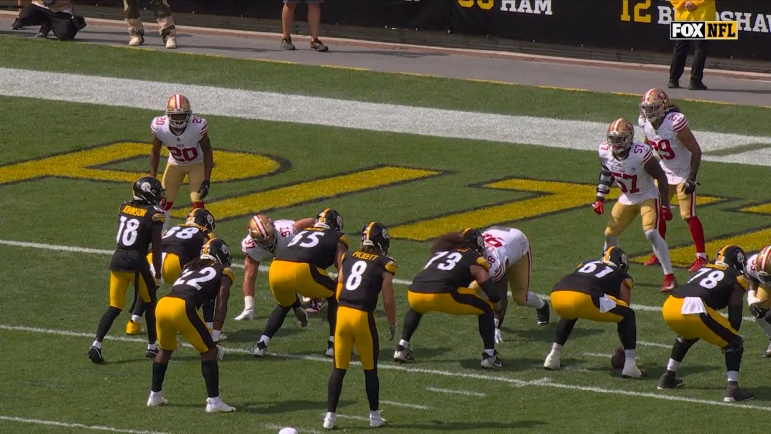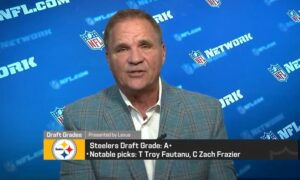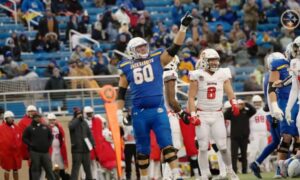When Pittsburgh Steelers team president Art Rooney II spoke to the media this past Monday, one topic he talked about was the possibility of addressing the offensive line. While Rooney did not guarantee that changes would be made, he did say the organization would be evaluating the linemen because better play was needed. One day later, the Steelers hired their new offensive coordinator, Arthur Smith.
With the offensive coordinator in place, we have the opportunity to look back on his time as OC of the Tennessee Titans and as head coach of the Atlanta Falcons (where he called the plays) to get an idea of what he likes in his linemen. Thankfully, we also have Alex Kozora’s in-depth look at Smith, which details some of Smith’s preferences, like explosive linemen who are big and physical and can also bend at the hip. Do the Steelers measurables match?
In order to help quantify how that has played out, one of the most useful tools we can use is the Relative Athletic Score. RAS was developed by Kent Lee Platte to help take all the measurements and testing scores of incoming rookie players gathered at the NFL Scouting Combine (or Pro Days if no Combine data) and compare them against other players at the same position through the years on a scale from 0-10. It’s not a perfect metric, but it gives us an idea of how players test relative to others at the position.
RAS also groups those tests into different areas: size, speed, explosion, and agility. Size is simply height, weight, and bench press. Speed is the 40-yard dash plus the 10- and 20-yard splits. Explosion is a player’s vertical and broad jump scores, and agility combines shuttle and three-cone times. That will give us an idea of what Smith tends to prefer and which linemen we need to study a little further to understand why they are outliers. It also will help us look at the current starting linemen in Pittsburgh to see how they stack up.
Linemen:
Offensive Tackle
While Smith was the offensive coordinator in Tennessee, he had two stellar tackles in Jack Conklin and Taylor Lewan. Then, in Atlanta, he also had Kaleb McGary and Jake Matthews. What did those four have in common? All had an RAS of at least nine, and Lewan was actually a perfect 10. The Titans also acquired Dennis Kelly and Isaiah Wilson between 2019 and 2020. Neither were the stellar RAS standouts that the four above were. Kelly had a 7.38 RAS due to his poor agility and was okay in the speed and explosion categories. Wilson was even lower at 7.25 RAS due to poor agility, but he did have a great explosion score due to his broad jump.
So, we can see that Smith has prioritized explosiveness in his offensive tackles at both stops. While you won’t see tackles jumping straight into the air or trying to launch themselves across the field with a standing jump, vertical and broad jumps do show off just how powerful a player’s legs are. The more force a player generates with his legs, the better job they can do firing off the ball and translating that force into a heavy impact when blocking.
As for Pittsburgh, Broderick Jones has a 9.58 RAS, putting him above both Matthews and Conklin and behind only McGary and Lewan in terms of Smith’s top tackles. Now, Jones isn’t on the same elite level of explosiveness as some of the other tackles, but he graded out as elite when it came to the speed metrics. We all saw how Jones fared as a run blocker as a rookie, and we also know Smith can coach a run game, so Jones should fit just fine along the offensive line. Plus, you have to imagine Smith likes seeing plays like the one below.
Now for the proverbial elephant in the room. OT Dan Moore Jr. found himself squarely the target of Steelers fans’ ire often during 2023, and Pro Football Focus agreed as the site graded Moore as the worst pass-blocking offensive tackle this past season. He was not the worst at run blocking, ranking 42nd out of 58 qualifying tackles. Whether it’s Jones replacing him at left tackle or the Steelers investing resources into the tackle position for the second straight season, people want Moore relegated to the bench at best and gone from the roster at worst.
So you would expect Moore’s RAS to be pretty rough, right? Well, while it’s not at the same level as Jones, Moore got an RAS of 8.97. His size was simply okay relative to other tackles; he had good speed and agility ratings, and he had elite explosiveness. What to make of that? Perhaps a change in offense could elevate Moore’s game. Or it shows that it isn’t all about elite measurables; they just give us an idea of what sort of physical base Smith looks for.
Guard
In the deep dive by Kozora linked above, he recounts that Smith’s prototypical offensive lineman in regard to both play style and size is Rodger Saffold. Unsurprisingly, Saffold possessed quality athletic scores for guards, posting an RAS of 9.49. His speed was good, his agility was great, and he had elite explosiveness. Interestingly enough, Saffold’s fellow guard in Tennessee, Nate Davis, had one of the lowest RAS of any of Smith’s linemen, especially starters, at 6.15. He possessed good explosion and speed metrics while he was just okay in terms of his size and agility.
In Atlanta, Smith had some extremely high-scoring guards in Chris Lindstrom and Matthew Bergeron. Lindstrom was already in Atlanta when Smith came in as head coach, and his 9.85 RAS certainly gave him a great platform to stay anchored in the starting lineup. Bergeron played offensive tackle in college, but after the Falcons drafted him in 2023, they kicked him inside to guard. Based on his RAS, you can understand why. As a tackle, he posted a respectable 8.72, but when you compare his measurables to guards, his RAS skyrockets to 9.82.
In Pittsburgh, the guard situation is not as rosy as the Falcons’. LG Isaac Seumalo did not have great measurables and consequently had a RAS of 7.82, ahead of only Davis in Tennessee in terms of Smith’s starting guards. Seumalo’s explosion measurables only ranked as okay, while he possessed great speed and agility metrics for the position. RG James Daniels fared a bit better with an RAS of 8.55. He took a hit purely for size, as he ranked poorly in terms of height, weight, and bench press. However, he made up for that by having elite agility and great explosion for a guard.
Center
Smith had three centers during his time in Tennessee and Atlanta, and they ran the absolute gamut in RAS. In Kozora’s profile of Smith, Smith extolled the virtues of Titans C Ben Jones. According to Smith, Jones had a big impact in the locker room as a leader, and while he did not possess the standard size of an NFL lineman, his intangibles in terms of his attitude and his football IQ were the best Smith had seen. Jones only had an RAS of 4.59, an incredible outlier in the entire study. He was bad in speed and agility compared to other centers, but he did grade out with great explosion among centers.
When Smith went to Atlanta, he had Matt Hennessy, who had an RAS of 8.9 with good size and speed and great agility and explosiveness. However, ahead of the 2021 season, the Falcons drafted Drew Dalman out of Stanford. Hennessy started in 2021, but Dalman took over the starting role in 2022 and did not look back. His RAS score of 9.90 certainly did not hurt him. He actually graded out as only okay in terms of his size due in large part to his weight (299 pounds) However, he possessed elite measurables in every other category for centers.
Steelers C Mason Cole, unfortunately, is much closer to Jones in Tennessee than Dalman. Cole had an RAS of 6.27, ranking poorly in both his explosive and agility metrics while boasting good speed and great size. Interestingly enough, he was likely held back from being elite in size due to his poor bench press.
Final Thoughts
Now we see examples throughout Smith’s coaching career that measurables are guidelines, not hard-and-fast rules. The mental aspect of the game is essential, which is why Smith speaks so highly of Ben Jones, the player who had the lowest RAS score of any linemen Smith coached. So, less-than-ideal measurables will not disqualify a lineman from starting. However, it’s easy to figure out that Smith does seemingly favor linemen who can physically assert themselves on the line of scrimmage.
So, I would not disqualify a guard like Isaac Seumalo just because he doesn’t measure up to Smith’s prototypical guard. However, when you factor in snapping issues, Cole’s low RAS score could make the center spot a priority for upgrading this offseason. On the flip side, Moore’s RAS score is not that far off Smith’s apparent preferences, but the results on the field have not lived up to the physical attributes. Could Smith coach him up? It’s certainly a possibility, but how Smith handles Moore will certainly be something to keep an eye on this offseason.
Then, we can apply some of these prototypical numbers to some of the incoming rookies to give us an idea of players that the Steelers may covet in the upcoming draft.









